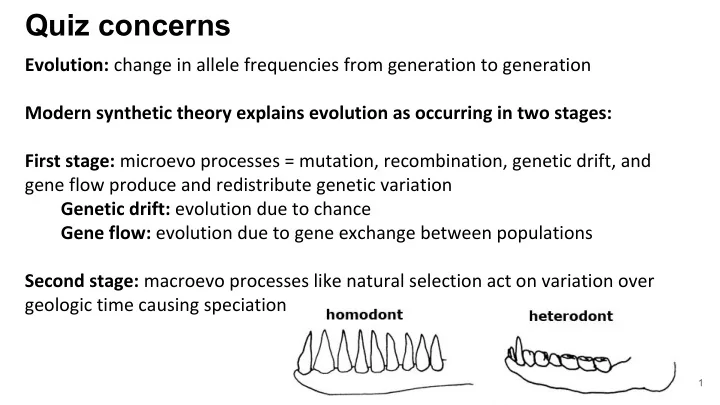

Quiz concerns Evolution: change in allele frequencies from generation to generation Modern synthetic theory explains evolution as occurring in two stages: First stage: microevo processes = mutation, recombination, genetic drift, and gene flow produce and redistribute genetic variation Genetic drift: evolution due to chance Gene flow: evolution due to gene exchange between populations Second stage: macroevo processes like natural selection act on variation over geologic time causing speciation 1
2
3
Last time: prosimians and tarsiers Today: Anthropoids 4
Anthropoids monkeys, apes, humans Traits distinguishing the anthropoids from prosimians... -increased parental care -more mutual grooming 5
Monkeys -85% of all primate species Divided geographically: New World monkeys and Old World monkeys 6
New World Monkeys Where: Central and South America -almost exclusively arboreal - prehensile tail 7
New World Monkeys (example) Tamarins and marmosets -smallest monkeys -claws (ancestral trait) -twin births -males more involved in infant care 8
Old World Monkeys (Cercopithecidae) Where: Africa to Southeast Asian islands -sexual dimorphism -females have swelling and redness during estrus Divided into subfamilies: Cercopithecines Colobines 9
Cercopithecines Baboons, mandrills, and macaques Where: Africa and Asia Diet: omnivorous Traits -terrestrial baboons have ischial callosities 10
Old World Monkeys: Colobines Colobines Where: Africa and Asia Diet: folivorous Traits -leaf-eating monkeys -segmented stomachs 11
Hominoids: apes and humans Traits distinguishing them from monkeys Continued evolutionary trends: -longer infant developmental periods -more complex brains and behavior -larger body size and brainier -shortened trunk -arms longer than legs -no tail 12
Gibbons and siamangs Where: tropic areas of southeast Asia Diet: omnivorous Brachiation: suspensory locomotion involving arm swinging Traits: adaptations to brachiation -muscled shoulders -long arms -curved fingers https://youtu.be/U3JhwjNfx_g 13
Orangutans Where: forests of Borneo and Sumatra Diet: frugivorous Traits -almost completely arboreal -solitary 14
Gorillas Where: Africa (east/west lowland, and mtn gorillas) Diet: vegetarians Traits -largest living primates -sexual dimorphism 15
Hominoids Chimpanzees Where: equatorial Africa Diet: omnivorous plus other animals Traits -knuckle-walking on ground -brachiation in trees Social: large fluid communities -form lifelong attachments 16
Hominoids Bonobos Where: areas south of Zaire River Diet: omnivorous Traits -copulate throughout estrus cycle -female-centered communities -female-female and male-male sexual behaviors 17
Hominoids - humans Homo sapiens Where: found everywhere in all climates Diet: omnivorous Traits -only living bipeds -brainsize increased enormously -entirely dependent on culture 18
Recommend
More recommend